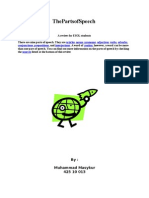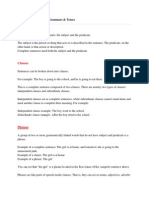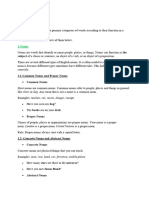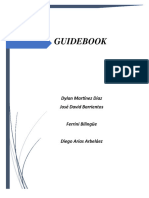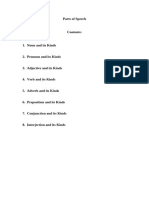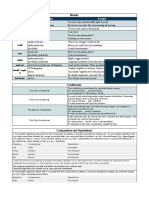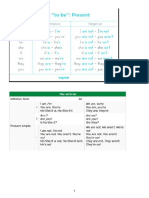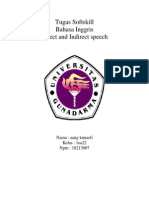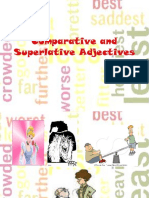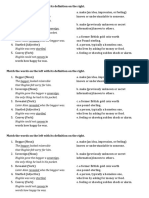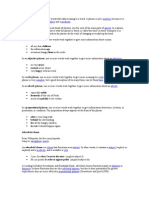0 ratings0% found this document useful (0 votes)
97 viewsThepartsofspeech
Thepartsofspeech
Uploaded by
api-263620264Copyright:
© All Rights Reserved
Available Formats
Download as DOCX, PDF, TXT or read online from Scribd
Thepartsofspeech
Thepartsofspeech
Uploaded by
api-2636202640 ratings0% found this document useful (0 votes)
97 views15 pagesOriginal Title
thepartsofspeech
Copyright
© © All Rights Reserved
Available Formats
DOCX, PDF, TXT or read online from Scribd
Share this document
Did you find this document useful?
Is this content inappropriate?
Copyright:
© All Rights Reserved
Available Formats
Download as DOCX, PDF, TXT or read online from Scribd
Download as docx, pdf, or txt
0 ratings0% found this document useful (0 votes)
97 views15 pagesThepartsofspeech
Thepartsofspeech
Uploaded by
api-263620264Copyright:
© All Rights Reserved
Available Formats
Download as DOCX, PDF, TXT or read online from Scribd
Download as docx, pdf, or txt
You are on page 1of 15
ThePartsofSpeech
There are nine parts of speech. They
are articles, nouns, pronouns, adjectives, verbs, adverbs, conjunctions, prepositions,
and interjections. A word of caution, however, a word can be more than one part of speech.
You can find out more information on the parts of speech by checking the sources listed at
the bottom of this review.
Nouns
A noun is a word used to name something: a person/animal,
a place, a thing, or an idea. For example, all of the following are nouns.
o Amina, Mohammad, Yusuf, Tarek
o Japan, Venezuela, Atlanta, Kroger, the Gap
o pencil, store, room, air
o biology, theory of Relativity, Pythagorean theory
Hint: They are sometimes preceded by noun markers. Noun markers are also called determiners and
quantifiers. They are words like a, an, the, this, that, these, those, each, some, any, every, no, numbers
(1,2,3,etc.), several, many, a lot, few, possessive pronouns (his, her, etc). See determiners for more information.
Nouns are classified in several ways
1. Nouns can be singular or plural.
Singular nouns name only one person, place, thing or idea.
One apple, a pencil, the book
Plural nouns name two or more persons, places, things or ideas. Most singular nouns (Not ALL) are
made plural by adding s. For example, (pencil is a singular noun. The word pencils is a plural noun.)
Exception #1: If a noun ends with the s, sh, ch, or x like the words, bliss, crash, ash or box, then
they are made plural by adding es (blisses, crashes, ashes, and boxes).
Exception #2: There are also irregular nouns that do not follow any rules. For example, the plural
form of the word child is children.
Nouns can be Proper Nouns or Common Nouns
A. Proper nouns refer to specific people, places, things and ideas. A person's name (Leah Graham) is a
proper noun, for example. Other examples are names of places (Atlanta, Georgia) and names of things
(the Navy). They are always capitalized!
o Peoples names and titles- King Henry, Mrs. Smith
o Names for deity, religions, religious followers, and sacred books- God, Allah,
Buddha, Islam, Catholicism, Christians
o Races, nationalities, tribes, and languages- African American, Polish-American,
Black, Chinese, Russian
o Specific Places like countries, cities, bodies of water, streets, buildings, and parks
o Specific organizations- Central Intelligence Agency (CIA), .
o Days of the week, months, and holidays,
o Brand names of products
o Historical periods, well-known events, and documents- Middle ages, Boston Tea
Party, Magna Carta
o Titles of publications and written documents
B. Common nouns are all other nouns. For example: cat, pencil, paper, etc. They are not capitalized unless
they are the first word in the sentence.
Nouns can also be collective.
Collective nouns are nouns that are grammatically considered singular, but include more than one
person, place, thing, or idea in its meaning. Words like team, group, jury, committee, audience, crowd,
class, troop, family, team, couple, band, herd, quartet, and society.
Generally, collective nouns are treated as singular because they emphasize the group as one unit.
The committee is going to make a decision.
Nouns can also be either count or non-count.
Nouns that are non-count cannot be counted. For example,
one cannot go outside to have two fresh airs. One goes outside for fresh air.
5. Nouns can be Abstract or concrete
Concrete nouns are nouns that you can touch. They are people, places, and some things. Words
like person, court, Georgia, pencil, hand, paper, car, and door are all examples of concrete nouns.
Abstract nouns are nouns that cannot be physically held. For example, things like air, justice, safety,
Democracy, faith, religion, etc.
6. Nouns can be Gerunds
A gerund is the ing form of the verb and is used as a noun. For example,
Running is good for you.
Running is the noun/gerund and is is the verb.
My crying upset him.
Crying is the subject and upset is the verb
Note: A noun can fit into more than one of these categories. For example, the noun Angela is a singular,
concrete, count, proper noun.
Pronouns
A pronoun is a word that replaces a noun. They eliminate the need for repetition.
For Example:
Instead of Emma talked to Emma's child, you might say Emma talked to her child.
Her is the pronoun. It renames the antecedent, Emma.
There are several types of pronouns.
Personal Pronouns refer to specific persons or things. Personal pronouns can act as subjects, objects, or
possessives.
Singular: I, me, you, she, her, he, him, it
Plural: we, us, you, they, them
I, you, she, he, it, we, and they are used as subjects of sentences.
For example, She knew the grammar rules very well.
The personal pronouns that can be used as objects are:
Me, you, him, her, it, them
For Example:
The teacher gave all of themgood grades.
Abdullah gave his poetry book to her.
Then, Azra gave it to me.
Them, her and me are personal pronouns used as objects. They are NEVER the subjects of the sentences.
Possessive Pronouns indicate ownership or possession.
Singular: my, mine, your, yours, hers, his, its
Plural: yours, ours, theirs,
For Example: She returned my pencil to me because it was mine.
3. Reflexive Pronouns name a receiver of an action who is identical to the doer of the action.
Singular: myself, yourself, himself, herself, itself
Plural: ourselves, yourselves, themselves
For example: Nadia congratulated herself on her good grades.
Here, Nadia is both the doer and the receiver of the action.
Q: So, who did Nadia congratulate? A: Herself.
4. Intensive Pronouns emphasize a noun or another pronoun.
Singular: myself, yourself, himself, herself, itself
Plural: ourselves, yourselves, themselves
For Example: I saw Omar Sulaiman himself at the masjid.
Here, himself emphasizes the antecedent, Omar Sulaiman.
5. Reciprocal Pronouns express shared actions or feelings. They are:
Each other One another
For Example:
Khadijah and Ayesha help each other with their homework.
Uthman and his mom pray with one another when they go to the masjid.
6. Indefinite Pronouns refer to non-specific persons and things.
All, another, any, anybody, anyone, anything, both, each, either, everybody, everyone, everything, few,
many, neither, nobody, none, no one, nothing, one, several, some, somebody, someone, something
For Example:
Many believe that UFOs exist, but nobody can prove it.
No one can be sure if aliens really exist, but only few wonder if Elvis is still alive.
The underlined indefinite pronouns do not refer to any one person. They are referring to people in general.
7. Demonstrative Pronouns are also considered noun markers. They "point" towards nouns.
this, that, these those
For Example:
That woman attends Gainesville College.
That points out which woman.
The woman attends Gainesville College.
Q: Which woman? A: That woman.
8. Interrogative Pronouns introduce questions.
Who, Whom, Whose, Which, What
For Example:
Who is going on vacation? To whom will the teacher give an "A"?
What are you doing?
9. Relative Pronouns introduce dependent clauses and refers to a person or thing already mentioned in the
sentence (i.e. the antecedent).
Who, whoever, whom, whomever, whose, which, that
For Example:
The English that we learn in class will help us pass English 1101.
that we learn in class is the adjective clause that describes English. And, that is the relative pronoun.
Q: Which English?
A: The English that we learn in classas opposed to the English we learn around our friends.
Note: Adjectives clauses modify nouns or pronouns, and usually answer one of the following
questions: Which one? What kind of? They begin with a relative pronoun or a relative adverb (when or where).
Adjectives
An adjective modifies (describes) a noun or pronoun.
Normally in English, the adjective comes before the noun. For example:
The smart student earned an "A".
They also come after linking verbs. For example:
I feel happy.
Adjectives can be used to make comparisons.
For most adjectives of one or two syllables, you can add er. For example, greater, faster, stronger.
For adjectives longer than two syllables, you should use the word more.
For example, He was more intelligent than his sister was.
Adjectives can also be used as superlatives.
This is usually done by adding est to the end of an adjective that is one or two syllables.
For example, the loudest, the coolest, the smartest.
If an adjective is three syllables or longer, you must use the words the most. For example:
Yasmin is the most intelligent person in the world!
WARNING- Never use both an er ending and the word moreor an
est ending and the word most.
For example, I am the most happiest when my students learn. Instead, it should be: I am
the happiest when my students learn.
There are some irregular adjective and adverb forms. For example:
Adjective Adverb Comparing two Comparing three
or more
Bad badly Worse worst
Good Well Better Best
Little Less Least
Much Many More Most
Punctuation Note: Adjectives are not usually capitalized unless they are the first word in a
sentence. BUT, nationalities are also adjectives and should be capitalized. For example:
Ricky Martin is Puerto Rican and Michelle Yeoh is Chinese.
These are called proper adjectives. And, like proper nouns, proper adjectives are always capitalized in English.
They are derived from proper nouns and are words like: African-American, Vietnamese, Latino, Italian,
Japanese, Korean, etc. They can also include adjectives like Catholic, Jewish, Republican, Democrat, etc.
When they are used together, they are arranged in a certain order.
Determiner*
Opinion Size Age Color Origin Material Noun
The, This
Some
Pretty
Tall
Big
Thin
New
Old
Blue
Purple
Puerto
Rican
Leather
Wood
Sofa
My
Expensive
Small Ancient Black Chinese Silk Scarf
For Example:
I saw that tall, thin, old, blue, silk scarf at the store and I bought it.
Ahmed drives an expensive old I talian car.
You wouldnt ordinarily use so many adjectives in just one sentence.
*Note: Determiners include articles, demonstrative pronouns, indefinite pronouns and possessive pronouns.
Adverbs
An adverb is a word that modifies an action verb, an adjective or another adverb.
The teacher carefully graded the homework.
Carefully is an adverb that modifies the action verb to grade.
Saleh was extremely enthusiastic about doing his homework.
Extremely is an adverb that modifies the adjective enthusiastic.
Sahil ran out of the classroom very quickly.
Very is an adverb that modifies the adverb quickly.
Warning: You need an adjective after linking verbsNEVER an adverb!
For example: Jannah feels bad (guilty) when she has to leave class.
Here, bad is an adjective that modifies the proper noun Jannah. It is an adjective because it follows the linking
verb to feel.
HOWEVER, verbs like look, sound, smell, feel, and taste can function as either an action verb or a linking
verb.
Jannah feels badly (to the touch) after swimming in a chlorinated pool. Her skin is really dry.
Here, bad is used in its adverbial form since it follows an action verb, to feel.
Types of Adverbs:
Relative Adverbs introduce questions and dependent adverbial clauses. They answer the
questions When? and Where? They are:
When Where
For Example:
When I was young, I liked to play outside.
Q: When did I like to play outside? A: When I was young.
Adverbs of Frequency indicate answer the question how often? They are:
Always, usually, often, sometimes, rarely, never
The students in Shajara Tayyiba always study very hard.
They rarely forget to do their homework.
NOTE: Generally, these adverbs come before the verb; however there is an exception. In the case of
the verb to be, the adverb of frequency comes after the verb. For example: Azra is always on time for
class.
Conjunctions are the scotch tape of the grammatical world. They join together words and phrases.
There are three kinds of conjunctions: coordinating conjunctions, correlative conjunctions, and subordinating
conjunctions.
1. Coordinating Conjunctions
There are seven coordinating conjunctions in English. You can use the mnemonic device fanboys to remember
them.
For
And
Nor
But
Or
Yet
So
They can be used with commas to create compound sentences. For example:
Sumaiyyah loves to read, but Mariam has no books.
Shaila works hard, yet she still earns low grades.
Note: A compound sentence is a sentence made up of two independent clauses. That is, a compound
sentence is simply two complete sentences joined by a comma and a coordinating conjunction (i.e. a fanboys).
2. Correlative Conjunctions also join ideas, but they work in pairs. They are:
Bothand
neithernor
whetheror
eitheror
not onlybut also
For Example:
Not only am I happy about the grades, but I am also excited that you are learning!
3. Subordinating Conjunctions join an independent clause to a subordinate clause. That is, they join a clause
that can stand alone with a clause that cannot stand alone. Some frequently used subordinating conjunctions are:
after, although, as, as if, because, before, even if, even though, if, since, so that, though, unless, until, when,
whenever, where, wherever, whether, while.
For Example:
Although the students were tired, they still came to class.
Interjections
Interjections are words used to express emotional states. They can usually be found in narrative writing,
interviews, and in spoken English. They can stand alone. For example:
Oh!, wow!, Ouch! Oops! Hey!
Punctuation Note: They are punctuated with either commas or exclamation marks. Mild interjections are
followed by a comma, but stronger interjections are punctuated with an exclamation mark (!) .
Oh, were late for the show.
Generally, the show is not an important destination. Therefore, the person making this statement will sound less
urgent than the next example.
Oh! Im late for work.
Work, unlike the movies, is generally considered a very important destination. If one doesnt arrive on time,
there is the possibility of being fired or of losing face. Here, the speaker will have a greater sense of urgency.
Generally , you do not find interjections in academic writing.
Prepositions
Prepositions are words that, like conjunctions, connect a noun or pronoun to another word in a sentence. Some
common prepositions:
About Before Down Into Through
Above Behind During Like To
Across Below Except Of Toward
After Beneath For Off Under
Among Beside From On Up
Around Between In Over With
At By Instead of Since Without
A prepositional phrase is a group of words that begins with a preposition and ends with a noun or pronoun.
They can act as adjectives or as adverbs.
Maria, the student from Germany, wrote an excellent paper on the computer.
Verbs
Verbs generally express action or a state of being. There are several classifications for verbs- action
verbs,/linking verbs, main verbs/auxiliary verbs, transitive/intransitive and phrasal verbs.
1. Action verbs show action.
He runs. He plays. They study.
2. Linking Verbs link the subject to an adjective.
Prophet Yusuf is beautiful.
The linking verb is links the adjective beautiful with the subject Prophet Yusuf.
1. Main verbs can stand alone.
2. Auxiliary verbs, also called helping verbs, serve as support to the main verb.
The most common auxiliary verbs are:
Have, has, had
Do, does, did
Be, am, is, are, was, were, being, been
Should, could, will, would, might, can, may, must, shall, ought (to)
For example:
Yunus has run everyday.
Run is an action verb. The subject can actually "do" it.
Has is the helping verb. It helps the main verb run to be present perfect tense.
Verbs can be transitive or intransitive.
Transitive Verbs require a direct object in order to make sense.
For Example:
Zainab takes aspirin for her headaches.
Here, takes is a transitive verb since the sentence Zainab takes has no meaning without its direct
object aspirin.
Intransitive Verbs do not need direct objects to make them meaningful. For Example:
Ibrahim swims.
The verb swim has meaning for the reader without an object.
Caution: A verb can be either transitive or intransitive depending on its context. For Example:
The cars race. Here, race is intransitive. It does not need an object.
My father races horses. Here, races is transitive. It requires the object horses in order to make sense.
Verbs can be phrasal.
1. Phrasal verbs are made up of a verb and a preposition. The preposition gives the verb a different
meaning than it would have by itself. For example, the verb look has a different meaning from the
phrasal verb look up (in the dictionary).
Some more examples:
call up, find out, hand in, make up, put off, turn on, write up
WARNING: The base form of a verb is called the infinitive. It is to + verb. For example, to do, to win, to
study, etc. Under no circumstance can a verb preceded by to be considered a verb. Infinitives are not verbs.
Articlesare the, a, and an.
Q: What do articles do in a sentence?
A: Articles signal that a noun is going to
follow.
Example:
Who invented the telephone? The wheel?
The refrigerator? The airplane?
A cat was chasing a mouse in my back yard.
Modifiers (adjectives & adverbs) can appear between an article and a noun.
Examples:
A sunset.
A spectacular sunset.
An exceptionally spectacular sunset.
The indefinite article a can only appear before nouns that begin with a
consonant sound: a hand, a book, a world, a computer
The indefinite article an can only appear before nouns that begin with a
vowel sound: an apartment, an hour, an article
General Rules for the Use of Articles:
I. Use a/an with singular count nouns whose specific identity is not known to the reader either because it is
being mentioned for the first time, or because its specific identity is unknown even to the writer.
Examples:
Musa arrived in a limousine. (a = one among many. Not a specific one.)
Were looking for an apartment. (an = any one.)
II. Do not use a/an with non-count nouns. Only use a/an with non-count nouns if you add a count noun in front of
the non-count noun.
Example:
Amen asked her mother for an advice.
Amen asked her mother for a piece of advice.
III. Use the with most nouns whose specific identity is known to the reader because:
1. The noun has been previously mentioned:
o Yesterday I saw a group of ESL students. The students were playing with a ball. The ball was white
and blue. The ball rolled into a hole. The hole was small.
2. The noun is made specific by a superlative:
o I bought the fastest computer they had.
3. The noun describes a unique person, place, or thing:
o Please give this to the manager.
o The sun is bright today.
o Rain is falling heavily in the North.
4. The context or situation makes the nouns identity clear:
o Please dont slam the door when you leave.
o Omar warned me that the dog playing in his yard is very affectionate and jumps on every person
it meets.
5. Do not use the with plural or non-count nouns meaning "all" or "in general" (i.e. generic reference nouns).
Do not use the with most singular proper nouns.
The fountains are an expensive element of landscape design.
In some parts of the world, the rice is preferred to all other grains.
6. Do not use articles with other noun markers or determiners, i.e. possessive nouns (Helens) ; and some
pronouns (his, her, its, ours, their, whose, this, that, these, those, all, any, each, either, every, few, many, more,
most, much, neither, several, some).
Exceptions:
All the
A few
The most
Examples:
Hasinas book is on the floor.
This book belongs to Tanweer.
A final caution- A word can be more than one part of speech. For
example:
I sat on the sofa.
Above, sofa is used as a noun (object of the preposition).
I slept on the sofa bed.
But, here sofa is used as an adjective to modify the noun bed.
And, native speakers often take poetic license with words in conversation. For example:
Its Sofa city for you!
Here, sofa acts as an adjective to describe the noun city. The meaning of the sentence is that the person will
have to sleep on the sofa, not a bed.
Sources:
Azar, B. (1992). Fundamentals of English grammar 2
nd
ed. Englewood Cliffs, NJ: Prentice Hall Regents.
Hacker, D. (1989). A writers reference. New York: St. Martins
Press, Inc.
Hayes, C. (1996). English at hand. Marlton, NJ: Townsend Press.
Leahs head.
Shono, S. (Fall 1998). ESL 0650 Articles Handout.
You might also like
- The Grammar Bible: Everything You Always Wanted to Know About Grammar but Didn't Know Whom to AskFrom EverandThe Grammar Bible: Everything You Always Wanted to Know About Grammar but Didn't Know Whom to AskRating: 4 out of 5 stars4/5 (25)
- Module III - Punctuation and CapitalizationDocument110 pagesModule III - Punctuation and CapitalizationAnonymous FHCJucNo ratings yet
- Eng Mod1Document26 pagesEng Mod1Tivar VictorNo ratings yet
- Parts of SpeechDocument45 pagesParts of SpeechVitaManiezt100% (3)
- Parts of SpeeckDocument13 pagesParts of SpeeckMarietta SzabóováNo ratings yet
- LPAT_notesDocument26 pagesLPAT_notespoonrita66No ratings yet
- SpeechDocument15 pagesSpeechMahboob RiazNo ratings yet
- A Noun Is A Word Used As The Name of A PersonDocument18 pagesA Noun Is A Word Used As The Name of A PersonSharib SheraziNo ratings yet
- Nouns Can Be Proper Nouns or Common NounsDocument18 pagesNouns Can Be Proper Nouns or Common NounsSi Aby ReyesNo ratings yet
- 9 Parts of SpeechDocument13 pages9 Parts of Speechmasykur8d1No ratings yet
- Modul Bahasa InggrisDocument28 pagesModul Bahasa InggrisJ4 LiusNo ratings yet
- Eng Worksheet Grammar 2Document12 pagesEng Worksheet Grammar 2Neha KalraNo ratings yet
- Materi - Ajar Parts of SpeechDocument20 pagesMateri - Ajar Parts of SpeechAbdullah Anugra100% (1)
- Part One: Parts of Speech: Speciality: Level: TeacherDocument7 pagesPart One: Parts of Speech: Speciality: Level: TeacherrikamikimyaraNo ratings yet
- PARTS OF SPEECH ProjectDocument13 pagesPARTS OF SPEECH ProjectSãéèďNo ratings yet
- Study Material ENG.101Document31 pagesStudy Material ENG.101Filmy Spot100% (1)
- GrammarDocument47 pagesGrammarHamimah Nasution IsmailNo ratings yet
- Parts of Speech in EnglishDocument23 pagesParts of Speech in EnglishNina fauziah100% (2)
- Englishppr1 2Document117 pagesEnglishppr1 2kaursardarni7593No ratings yet
- English Grammar Class 11 BoardDocument6 pagesEnglish Grammar Class 11 Boardibrahimmoeen3333No ratings yet
- Parts of Speech Rejoice & Happy After Seeing This Type of Late ST TechnologyDocument18 pagesParts of Speech Rejoice & Happy After Seeing This Type of Late ST TechnologyKrishan GuptaNo ratings yet
- Parts of Speech - NounDocument13 pagesParts of Speech - Nounsharad100% (1)
- Bronex 0Document13 pagesBronex 0Bronex Paul MarcianoNo ratings yet
- 1 Nouns Pronouns - DeterminersDocument7 pages1 Nouns Pronouns - Determinerssalak.anas01No ratings yet
- Sentences: Independent Clauses Act As Complete Sentences, While Subordinate Clauses Cannot Stand Alone andDocument9 pagesSentences: Independent Clauses Act As Complete Sentences, While Subordinate Clauses Cannot Stand Alone andThamizhman Mani100% (1)
- English Basic GrammarDocument12 pagesEnglish Basic GrammaribnuamungNo ratings yet
- University of Technology - English - Language - First - Year - 2018 - 2019Document47 pagesUniversity of Technology - English - Language - First - Year - 2018 - 2019Sajad HayderNo ratings yet
- Types of Parts of Speech NounDocument20 pagesTypes of Parts of Speech NounNurul Aida NionsiNo ratings yet
- All About GrammarDocument56 pagesAll About GrammarDeka Fab100% (1)
- Skill FinalDocument37 pagesSkill Finalkalai cgmNo ratings yet
- PronounsDocument16 pagesPronounsfatimatuzahra503No ratings yet
- Grammar Classes Detailed InformationDocument18 pagesGrammar Classes Detailed InformationDaniela De Arco VillaNo ratings yet
- Sentences: (TUTORIAL) All About Grammars & TensesDocument69 pagesSentences: (TUTORIAL) All About Grammars & Tenses3vilcatNo ratings yet
- Nouns, Verb, Adjective FullDocument5 pagesNouns, Verb, Adjective FullIbnu ShinaNo ratings yet
- Road To English BetterDocument65 pagesRoad To English BetterEko Nurhadi SatrioNo ratings yet
- 2 Forum InglesDocument4 pages2 Forum InglesRaimundo AfonsoNo ratings yet
- Grammar Guide: 1. WordsDocument16 pagesGrammar Guide: 1. WordsRania FarranNo ratings yet
- Basic English Grammar Notes MPDocument34 pagesBasic English Grammar Notes MPstephenzulu900No ratings yet
- Study Material ENG.101Document61 pagesStudy Material ENG.101AsmaNo ratings yet
- English Unit 2Document21 pagesEnglish Unit 2james rareNo ratings yet
- Parts of SpeechDocument6 pagesParts of SpeechBernardo Villavicencio VanNo ratings yet
- The Eight Parts of SpeechDocument7 pagesThe Eight Parts of SpeechJasmin Binauhan Niegos-Trongco100% (1)
- Nouns To AdjectiveDocument12 pagesNouns To AdjectiveAshley Casquejo MacanNo ratings yet
- Word ClassificationDocument28 pagesWord ClassificationmiftaNo ratings yet
- Parts of SpeechDocument6 pagesParts of SpeechCirineNo ratings yet
- NounDocument2 pagesNounShahzad BhuttaNo ratings yet
- Particular: Countable UncountableDocument4 pagesParticular: Countable UncountableHans AcedoNo ratings yet
- ENGLISH 1N (Remedial English) The Parts of SpeechDocument9 pagesENGLISH 1N (Remedial English) The Parts of Speechnaldima06No ratings yet
- Parts of SpeechDocument7 pagesParts of SpeechAdeel RazaNo ratings yet
- Grammatical-Categories 2.5Document12 pagesGrammatical-Categories 2.5arl somarNo ratings yet
- English Oh ReadDocument115 pagesEnglish Oh Readjoc3lyn_nNo ratings yet
- NounDocument15 pagesNounVanshNo ratings yet
- Guide - Words, Phrases, Clauses and SentencesDocument14 pagesGuide - Words, Phrases, Clauses and SentencesTomas G Salazar TNo ratings yet
- English Grammar 101Document10 pagesEnglish Grammar 101Talibovic TalibovNo ratings yet
- Guidebook (Recuperado)Document44 pagesGuidebook (Recuperado)dylandavid987No ratings yet
- English Grammar NotesDocument39 pagesEnglish Grammar Notestanzeela ilyasNo ratings yet
- Bahasa Inggris Bisnis 1Document59 pagesBahasa Inggris Bisnis 1Agung Junaedy100% (1)
- 7 Days to Grammar Excellence: How to Master English from Beginner to AdvancedFrom Everand7 Days to Grammar Excellence: How to Master English from Beginner to AdvancedNo ratings yet
- Comprehensive English Grammar Guide: From Basics to Competitive ExcellenceFrom EverandComprehensive English Grammar Guide: From Basics to Competitive ExcellenceNo ratings yet
- First Lessons in the Maori Language, with a Short VocabularyFrom EverandFirst Lessons in the Maori Language, with a Short VocabularyNo ratings yet
- Is Your English Improving?Document5 pagesIs Your English Improving?RalucaNo ratings yet
- STRESS and INTONATIONDocument19 pagesSTRESS and INTONATIONJen EstebanNo ratings yet
- Tenses Cheat Sheet (Intermediate) PDFDocument2 pagesTenses Cheat Sheet (Intermediate) PDFanon_824555781No ratings yet
- Character AnalysisDocument2 pagesCharacter AnalysisAlexis RamirezNo ratings yet
- A Handbook of The Ila LanguageDocument511 pagesA Handbook of The Ila LanguageGarvey Lives0% (1)
- Distinctive Features of Phonemes: April 2018Document4 pagesDistinctive Features of Phonemes: April 2018Utari ListiyaniNo ratings yet
- English Grammar Part 1 and 2Document435 pagesEnglish Grammar Part 1 and 2Dr.Ukihana SamuraiNo ratings yet
- Friedman - Romani in ContactDocument9 pagesFriedman - Romani in ContactZvonko NikodinovskiNo ratings yet
- Practical Phonetics NowackaDocument2 pagesPractical Phonetics NowackaLilia Bella LiliaNo ratings yet
- Priprema Za Test Iz EngleskogDocument22 pagesPriprema Za Test Iz EngleskogmilaNo ratings yet
- Yes or No QuestionDocument4 pagesYes or No QuestionSaritri RestuNo ratings yet
- PrepScholar 357 GRE Words ListDocument9 pagesPrepScholar 357 GRE Words ListReza AhamedNo ratings yet
- Different Types of Noun: Nouns Make Up The Largest Class of Words in Most Languages, Including English. ADocument19 pagesDifferent Types of Noun: Nouns Make Up The Largest Class of Words in Most Languages, Including English. Aellie parkNo ratings yet
- Adjective ClauseDocument20 pagesAdjective ClauseFatkhur RozaqNo ratings yet
- Common Proper Singular Plural NounsDocument46 pagesCommon Proper Singular Plural Nounsjakeyeto100% (1)
- Ways of Expressing Emphasis in EnglishDocument5 pagesWays of Expressing Emphasis in EnglishNela VasileNo ratings yet
- Direct and IndirectDocument8 pagesDirect and IndirectAang KunaefiNo ratings yet
- Comparative and Superlative AdjectivesDocument19 pagesComparative and Superlative AdjectivesJoana GomesNo ratings yet
- Words and Their Parts: MorphologyDocument23 pagesWords and Their Parts: MorphologyRina ElsaNo ratings yet
- Varieties of ArabicDocument20 pagesVarieties of ArabicMahmoud Sami100% (1)
- Actividad 1 Ingles 4Document2 pagesActividad 1 Ingles 4Axel RosasNo ratings yet
- Match The Words On The Left With Its Definition On The RightDocument1 pageMatch The Words On The Left With Its Definition On The RightWahyu Anggun NingtyasNo ratings yet
- Master 120 Common Phrasal Verbs Course Handbook Answers To Frequently Asked QuestionsDocument3 pagesMaster 120 Common Phrasal Verbs Course Handbook Answers To Frequently Asked QuestionsSolidWorksNo ratings yet
- Hebrew GrammarDocument12 pagesHebrew GrammarUmair Tariq100% (2)
- 513639.SSGL 37 07 - Mate KapovicDocument125 pages513639.SSGL 37 07 - Mate KapovicpskruškeNo ratings yet
- Word List Introduction To Norwegian Day TwoDocument4 pagesWord List Introduction To Norwegian Day TwoanezaNo ratings yet
- SNR English 10 Cohesive DevicesDocument5 pagesSNR English 10 Cohesive DevicesKociNo ratings yet
- A Phrase Is A Small Group of Words That Adds Meaning To A WordDocument3 pagesA Phrase Is A Small Group of Words That Adds Meaning To A WordHera Dewi NugrahaNo ratings yet
- English I PaperkcDocument31 pagesEnglish I PaperkcRobertBellarmineNo ratings yet









